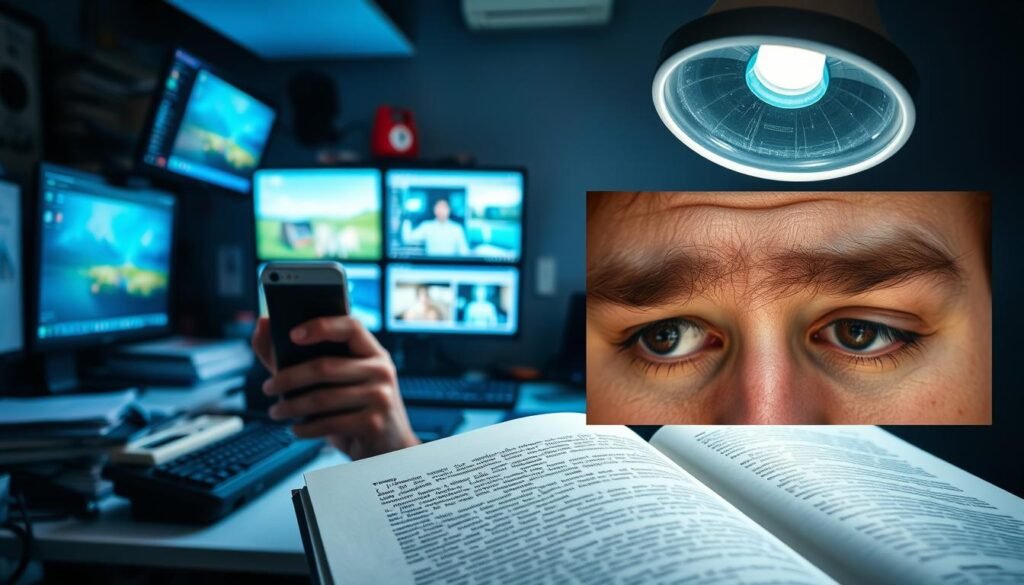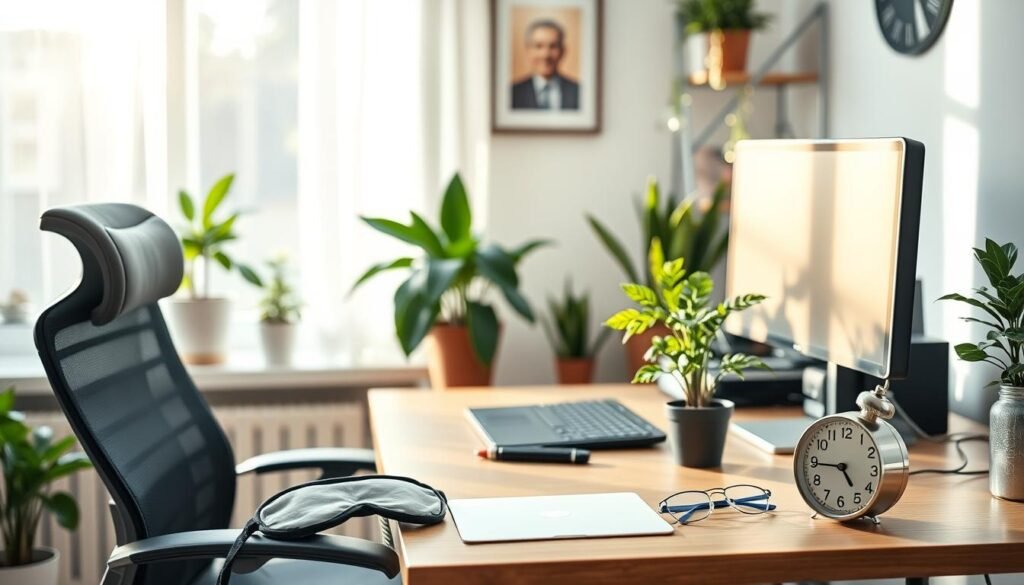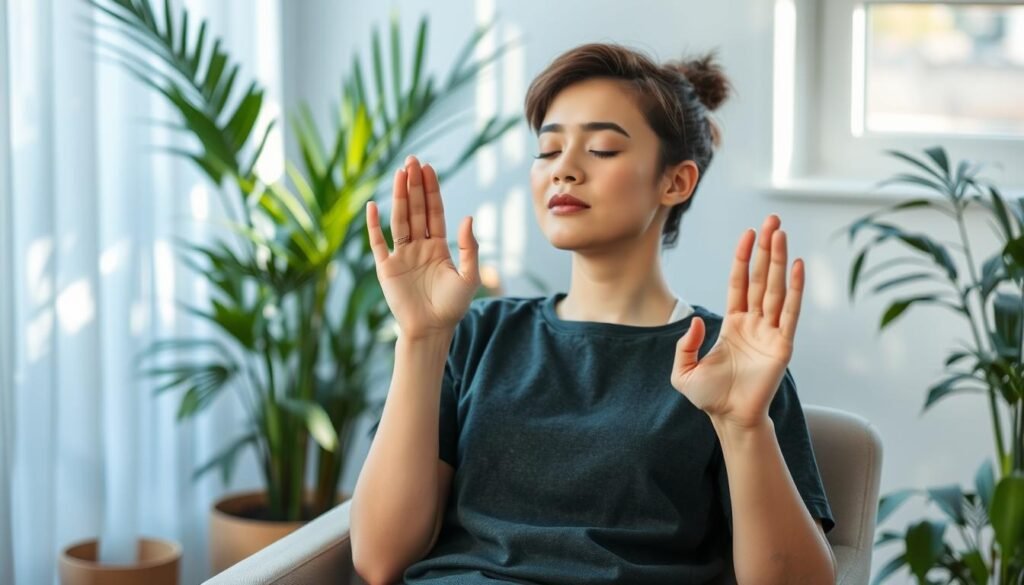Computer-related eye issues could lead to 10 million eye doctor visits each year. This shows how common eye fatigue is now. Because most of us use computers and digital devices daily, knowing how to treat eye fatigue matters. Screen time for too long can make us uncomfortable, less productive, and cause symptoms like blurred vision and eye strain. But there’s good news. There are many ways to ease digital eye strain that can improve how we feel and work. By understanding what causes eye fatigue and its symptoms, we can make our screen time better. We can also use simple tricks to treat it.
Key Takeaways
- Eye fatigue is a significant issue for those frequently using digital devices.
- 10 million annual visits to eye doctors highlight the seriousness of eye strain.
- Simple lifestyle adjustments can provide significant relief from symptoms.
- Following the 20-20-20 rule can help reduce the risk of eye strain.
- Proper eye care, including hydration and ergonomic setups, is crucial.
- Using artificial tears and warm compresses can alleviate discomfort.
- Blue light filter glasses can be useful in specific situations but are not a cure-all.
Understanding Eye Fatigue
Eye fatigue comes from the challenges of today’s lifestyles. It happens when we focus too hard for too long, especially on screens. People who spend a lot of time on computers or phones often feel it. Knowing its signs is key to treating it well.
What is Eye Fatigue?
Eye fatigue happens from lots of things, like reading a lot or staring at screens. Screen use is harder on the eyes than reading from paper. This is because of less blinking, screen glare, and bad angles. If you’re on screens for over two hours a day, you might risk your eye health.
Common Symptoms of Eye Fatigue
Eye fatigue symptoms include:
- Sore, tired, or burning eyes
- Blurred or double vision
- Dry or watery eyes
- Headaches and sensitivity to light
Other signs are having trouble focusing after looking away from screens. Spot these symptoms early to ease the effects and feel more comfortable.
Causes of Eye Fatigue
Understanding eye fatigue is key to improving daily life. One main cause is digital eye strain from too much screen time. People often feel dryness, blurriness, and discomfort. Up to 90% of computer users might get symptoms of eye fatigue.
Digital Eye Strain Overview
Too much time in front of screens leads to this condition. Staring at screens makes people blink less, causing dry and irritated eyes. The overview also points out how bad lighting and screen glare make things worse. Also, Binocular Visual Dysfunction (BVD) might cause headaches or double vision.
Impact of Screen Time on Eye Health
Screen time affects our eye health a lot in this digital era. Looking at screens can mess with our sleep and cause eye fatigue. The wrong screen position can make us strain our eyes. It’s important to keep screens at the right distance and have good workspace design.

Eye Fatigue Treatment: Lifestyle Adjustments
In today’s tech-filled world, simple lifestyle changes can greatly ease eye fatigue. These small adjustments can boost both eye comfort and overall health. For instance, a comfortable work space is key to fighting screen-related discomfort.
Importance of Proper Lighting Adjustment
Adjusting your lighting correctly is a big deal for reducing eye strain. Harsh overhead lights can make screen glare worse, adding discomfort. On the other hand, soft, diffused light improves screen visibility without straining the eyes.
Use task lights correctly when reading or using a computer. This helps to cut down on glare. You might even rearrange your furniture or get adjustable lamps for better lighting. Staying the right distance from your screen also eases eye fatigue.
Creating an Ergonomic Office Setup
An ergonomic setup is crucial for eye health. Your screen should be at eye level and an arm’s length away. This makes sure you’re comfortable.
Adjustable chairs and desks help you maintain good posture. This reduces eye and neck strain. Checking your workspace layout often stops bad posture habits. Accessories like monitor stands and wrist supports offer long-term benefits. The goal? A productive yet eye-friendly workspace.
The Role of Frequent Screen Breaks
Regular breaks from the screen are key in fighting eye fatigue. The 20-20-20 rule is easy: every 20 minutes, look at something 20 feet away for 20 seconds. This relaxes your eye muscles and lowers strain risk.
Balancing work with breaks boosts focus and keeps productivity up. Breaks refresh your mind, improving your day’s work.

Making these lifestyle tweaks significantly improves your working experience. Correct lighting and an ergonomic setup matter a lot. Taking breaks often is great for your eyes too. For more tips on easing eye strain, check out this page.
Eye Exercises for Relief
Eye exercises are key to reducing eye fatigue. These include focusing techniques and blinking often. Adding the best eye exercise methods into daily routines relaxes eye muscles. It also keeps eyes moist and fights off dryness from too much screen use.
Best Eye Exercise Techniques
Specific techniques can make your eyes more comfortable and relieve strain. Let’s explore some top methods:
- Palming: Place warm palms over closed eyes to soothe and relieve strain.
- Eye Rolls: Perform gentle eye rolls clockwise and counter-clockwise to ease muscle tension.
- Focus Change: Shift focus between a near object and a distant one to help reduce eye muscle tension.
- Vertical and Horizontal Movements: Close the eyes and move them up and down, then side to side to stretch tired muscles.
Incorporating Blink Exercise Routines
Adding a blink exercise routine helps keep eyes moist. People blink less when looking at screens, leading to dryness. Try the 20-20-20 rule: blink 20 times every 20 minutes while on a device. Also, exercises like the Eye Roll and Zooming can further relieve fatigue.
| Exercise | Description | Benefits |
|---|---|---|
| Palming | Cover closed eyes with warm palms | Relaxes eye muscles and reduces strain |
| Eye Rolls | Roll eyes in a circular motion | Alleviates tension in eye muscles |
| Focus Change | Shift gaze between close and distant objects | Improves focus flexibility |
| Rest Exercise | Close eyes for approximately 15 minutes | Supports eye recovery and health |

Utilizing Blue Light Filter Glasses
More and more, we rely on digital devices, raising concerns about effects of blue light on eyes. This has led to many people feeling eye strain and discomfort after spending a lot of time in front of screens. To combat this, blue light filter glasses have become quite popular. However, recent studies show that things might not be as straightforward as we thought regarding how effective these glasses are.
How Blue Light Affects Eyes
Blue light comes from our screens and can make us tired and hurt our sleep. It’s believed blue light stops melatonin production, which we need for good sleep. But, when looking at 17 detailed studies, researchers didn’t find blue light glasses much better than normal glasses for stopping eye strain. When it comes to sleep, some research says there’s a small improvement, while other studies don’t see a big difference.
Choosing the Right Blue Light Glasses
Even with mixed results about choosing blue light glasses, there are important things to think about. Important factors include:
- Lens Quality: High-quality materials are a must to filter blue light well.
- Prescription Compatibility: Make sure the glasses work with your vision needs.
- Intended Use: Decide if you need them for everyday screens, gaming, or reading.
Even though blue light glasses can make screen time more comfortable, the jury is still out on their full benefits. If you’re worried about eye health and sleep, keep an eye on new studies about blue light filter glasses. Staying updated is key.
Hydration and Dry Eye Relief Strategies
Staying hydrated is crucial for eye health. Not drinking enough water can lead to eye problems. It can cause irritation, blurry vision, and discomfort. Hydration strategies and using artificial tears can help a lot. They make your eyes more comfortable and reduce dryness and fatigue. Artificial tears provide needed moisture and make your eyes feel better.
Using Artificial Tears Effectively
Artificial tears help with dry eyes, burning, and sensitivity to light. They add important moisture to your eyes. This moisture is normally from the aqueous layer of your tears, which is mostly water. To use them well, you should:
- Choose drops that fit your symptoms.
- Use them many times a day if needed.
- Choose preservative-free types to avoid irritation.
Environmental Adjustments and Humidity Control
Making your environment better can fight dry eye symptoms. Keeping room humidity at 45% or more helps prevent irritation. Drinking plenty of water is key too. It helps make more tears and stops you from getting dehydrated. Dehydration can make dry eye worse.
- Use humidifiers when it’s dry.
- Avoid too much air conditioning and heat.
- Make sure your spaces are well-ventilated.
| Hydration Strategies | Benefits |
|---|---|
| Increased Water Intake | Aids in tear production, preventing dry eyes. |
| Use of Artificial Tears | Provides immediate relief and lubrication for the eyes. |
| Regulating Room Humidity | Reduces eye irritation by maintaining moisture in the air. |
| Limiting Caffeine and Alcohol | Decreases the risk of dehydration, supporting overall eye health. |
Computer Vision Syndrome Remedies
Understanding computer vision syndrome is key for digital device users. It comes from too much screen time. This causes tiredness, discomfort, and focusing problems. Tackling these issues can boost comfort and productivity.
Understanding Computer Vision Syndrome
Computer vision syndrome (CVS) affects many who work on computers or use digital devices often. Studies show that 50% to 90% of users feel its symptoms. These include dry eyes, blurry vision, and neck pain.
Working on computers makes people blink 66 percent less, leading to eye strain. Poor posture can also worsen symptoms. This makes good ergonomic habits vital.
Effective Remedies to Combat Symptoms
Using remedies for computer vision syndrome can lessen discomfort. Here are some helpful strategies:
- Follow the 20-20-20 rule: Every 20 minutes, look at something 20 feet away for 20 seconds. It helps eyes rest.
- Take regular breaks: After 2 hours of screen time, rest your eyes for 15 minutes to reduce strain.
- Ensure proper lighting: Adjust your workspace lighting to lessen glare and make seeing easier.
- Maintain an ergonomic office setup: Set up your monitor, chair, and tools to support good sitting habits.
- Utilize eye exercises: Simple eye exercises can ease muscle strain. Doing these regularly improves eye comfort.
To improve eye comfort and avoid CVS, recognizing signs and using remedies is crucial. For more strategies on managing fatigue and personalized treatment, click here.
Natural Remedies for Eye Fatigue
There are several natural ways to ease eye fatigue and improve eye health. Warm compresses are an easy, yet highly effective choice. Adding herbal treatments can offer extra benefits, especially if you spend a lot of time in front of screens.
Using Warm Compresses to Soothe Eyes
Warm compresses feel great on tired eyes. They boost blood flow and relax the eye muscles. Simply soak a clean cloth in warm water, squeeze out the excess, and put it over your closed eyes for around 10 minutes. This can help with discomfort, dryness, and make you feel more relaxed. Using it often can help with headaches and light sensitivity too.
Exploring Herbal Treatments and Supplements
Looking into herbal treatments and supplements adds support for your eyes. Herbs like bilberry and ginkgo biloba are known to help with eye function and blood flow. Omega-3 fatty acids can also keep your eyes moist, which is key to fighting off fatigue. Adopting these remedies could be a great way to look after your eye health on your own.
| Natural Remedy | Description | Benefits |
|---|---|---|
| Warm Compress | Soaked cloth in warm water applied to the eyes. | Relieves discomfort, enhances blood flow, and relaxes muscles. |
| Bilberry | Herb known for its antioxidant properties. | May improve night vision and support eye health. |
| Ginkgo Biloba | Herb that enhances blood flow and circulation. | Potentially supports visual function and reduces eye strain. |
| Omega-3 Fatty Acids | Essential fatty acids found in fish and flaxseed. | Helps maintain eye moisture, reducing dryness. |
Conclusion
It’s crucial to find ways to treat eye fatigue, to make everyday life more comfortable and productive. Nowadays, most Americans use screens for more than two hours a day. So, it’s important to know what causes eye fatigue and how to spot it. Making simple changes in our lifestyle can really help. This includes having good lighting and setting up your workspace the right way.
Office workers look at computer screens for about seven hours each day. Taking breaks, wearing blue light filtering glasses, and trying natural remedies can help too. Small steps can massively improve eye health and overall happiness. For those wanting to learn more, natural remedies can offer a complete approach to fight fatigue.
By focusing on eye care and watching our screen time, we can feel better and less tired. Taking action to solve common eye problems can improve our eyesight. It also makes us better at our daily tasks. Choose wisely and use the right treatments to avoid eye strain.